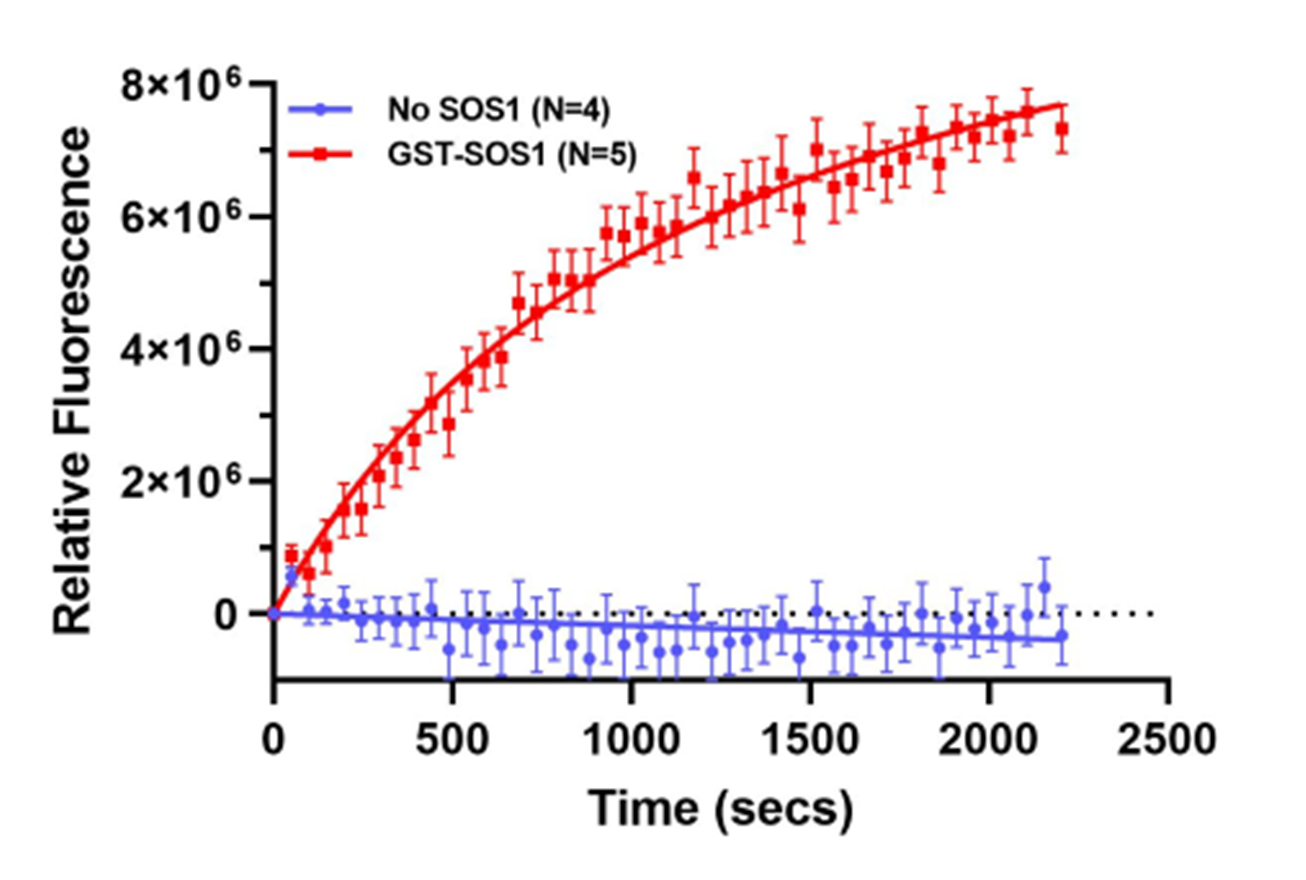SOS1 exchange domain (564-1049) protein : GST-tagged (Human recombinant)
SOS1 exchange domain (564-1049) protein : GST-tagged (Human recombinant)
* Limited stock available. If stock is not available, Cytoskeleton will produce a new batch upon request. Minimum order will apply. Inquire for more information.
Product Uses
- Study inhibitors of SOS1 GTP exchange activity
- Identification of SOS1 binding proteins
- Study of SOS1 GEF activity with different GTPases.
Materials
The human SOS1 exchange domain (564-1049) protein (SOS1-ExD) has been produced in a bacterial expression system. The recombinant protein contains a glutathione S-transferase (GST-tag) at its amino terminus. The approximate molecular weight of the SOS1-ExD protein is 84 kDa. The protein is supplied as a lyophilized white powder.
Figure 1. GST-SOS1 ExD Protein Purity Determination.

Above: A 10 µg sample of recombinant GST-SOS1 ExD protein (molecular weight approx. 84 kD) was separated by electrophoresis in a 4-20% SDS-PAGE system. The protein was stained with Coomassie blue. Protein quantification was determined using the Precision Red Protein Assay Reagent (Cat.# ADV02). Mark12 molecular weight markers are from Invitrogen.
Storage and Reconstitution
The protein should be reconstituted to 5 mg/ml by the addition of 20 µl of cold distilled water. The protein will be in the following buffer; 50 mM Tris pH 7.5, 50 mM NaCl, 1.0 mM MgCl2, 7 % sucrose, and 0.8 % dextran. In order to maintain high biological activity of the protein, it is strongly recommended that the protein solution should be aliquoted into "experiment sized" aliquots and snap frozen in liquid nitrogen. The protein can be stored at -70°C for 6 months. Avoid repeated freeze-thaw cycles. The lyophilized protein is stable at 4°C for 1 year when stored desiccated (<10% humidity).
Biological Activity Assay
The biological activity of SOS1-ExD can be determined from its ability to catalyze nucleotide exchange on Ras isoforms (N,H, K) using the N-MAR-GTP fluorophore-based RAS-GEF exchange assay kit (Cat. # BK101). The emission intensity of the N-MAR-GTP fluorophore increases dramatically when bound to the GTPase KRAS-4B (Cat. # CS-RS03) (Figure 2) in the presence of SOS1-ExD. The reaction is monitored by fluorescence measurement at 485nm Ex / 535nm Em. Stringent quality control ensures that the exchange rate of N-MAR-GTP is enhanced at least five fold in the presence of 1.0 µM SOS1-ExD.
Reagents, Materials, and Equipment
1. GST-SOS1-ExD protein (Cat. # CS-GE10).
2. Ras protein (Cat. # RS01 (H-Ras), RS02 (N-Ras), RS03 (K-Ras), RS04 (K-Ras-G12V), or RS05 (R-Ras).
3. RAS GEF Exchange Assay Biochem Kit (Cat. # BK101).
4. 96-well plate fluorescence spectrophotometer.
Method
1. Place 5 mg/ml of GST-SOS1-ExD vial on ice and dilute to 0.83 µg/µl (10 µM) with ice cold 2x Exchange Buffer.
2. Place Ras vial on ice and dilute to 1.25 µg/µl (50 µM) with ice cold Exchange Buffer..
3. Add the following components together in a fresh 15 ml Falcon tube and mix well by pipetting or gentle vortex:
Component | Per Well |
2x Exchange Buffer | 50µl |
50 µM Ras | 2µl |
Nanopure H2O | 38µl |
Note: For a total mixture volume, multiply the volume of reagents per well by the number of wells in the experiment, plus add 20% volume for pipetting losses.
4. Set up the fluorimeter with Excitation wavelength at 485 nm +/-20 nm and emission wavelength at 535 nm +/- 20 nm at RT.
5. Aliquot the pre-loaded mixture to the assigned wells and place the plate in the fluorimeter.
6. Pipette 10 µl of 10 mM GST-SOS1-ExD in respective wells and immediately pipette up and down twice and start readings for 20 minutes.
7. Save the readings after the kinetic protocols are finished. The exchange rate can be calculated by reducing the data to max slope (using 12 pts) or Vmax with the software that accompanies the plate reader. The exchange curve can be achieved by export to Microsoft Excel.
Figure 2. GST-SOS1-ExD protein mediated N-MAR-GTP exchange on K-Ras4B.

Above: The small GTPase K-Ras4B protein (1 µM) and GST-SOS1 (1 µM) GTP-exchange reactions were conducted in a 96-well black flat bottom half-area plate (Corning Cat# 3686). Reactions were measured in SpectraMax iD5 fluorimeter (lex = 485 nm, lem = 535 nm). At time zero, 10 ml of 1 µM GST-SOS1 or buffer was pipetted in to the wells and the reactions were monitored for 40 min by reading every 49 sec..
For product Datasheets and MSDSs please click on the PDF links below.
If you have any questions concerning this product, please contact our Technical Service department at tservice@cytoskeleton.com
Coming soon! If you have any questions concerning this product, please contact our Technical Service department at tservice@cytoskeleton.com


